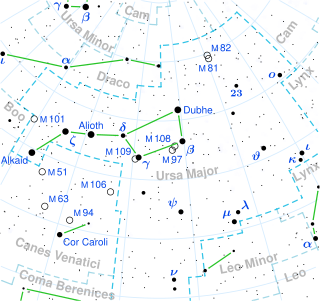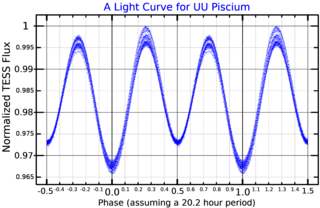Related Research Articles

Atlas, designation 27 Tauri, is a triple star system in the constellation of Taurus. It is a member of the Pleiades, an open star cluster (M45). It is 431 light-years away, and is 3.92 degrees north of the ecliptic.

Mizar is a second-magnitude star in the handle of the Big Dipper asterism in the constellation of Ursa Major. It has the Bayer designation ζ Ursae Majoris. It forms a well-known naked eye double star with the fainter star Alcor, and is itself a quadruple star system. The Mizar and Alcor system lies about 83 light-years away from the Sun, as measured by the Hipparcos astrometry satellite, and is part of the Ursa Major Moving Group.
Mu Ursae Majoris, formally named Tania Australis, is a binary star in the constellation of Ursa Major. An apparent visual magnitude of +3.06 places it among the brighter members of the constellation. Parallax measurements give an estimated distance of roughly 230 light-years from the Sun, with a margin of error of 4%.
Kappa Ursae Majoris is a binary star in the constellation of Ursa Major. With a combined apparent magnitude of +3.60, the system is approximately 358 light-years from Earth.

Upsilon Ursae Majoris, Latinized from υ Ursae Majoris, is a binary star in the northern circumpolar constellation of Ursa Major. It is visible to the naked eye with an apparent visual magnitude of +3.79. Based upon an annual parallax shift of 13.24 mas, it is located roughly 246 light-years from the Sun.

Omega Ursae Majoris is the Bayer designation for a binary star system in the northern circumpolar constellation of Ursa Major. It is visible to the naked eye with an apparent visual magnitude of 4.61. Based upon an annual parallax shift of 13.24 mas, it is roughly 246 light years from the Sun. At that distance, the visual magnitude of the star is diminished by an extinction factor of 0.11 due to interstellar dust.

Tau Ursae Majoris (τ UMa) is the Bayer designation for a binary star in the northern circumpolar constellation of Ursa Major. It is visible to the naked eye, having an apparent visual magnitude of 4.66. With an annual parallax shift of 25.82 mas, it is located about 126 light years from the Sun. At that distance, the visual magnitude is diminished by an extinction factor of 0.19 due to interstellar dust.

Rho Ursae Majoris (ρ UMa) is the Bayer designation for a solitary star in the northern circumpolar constellation of Ursa Major. It is faintly visible to the naked eye with an apparent visual magnitude of 4.74. The distance to this star, based upon an annual parallax shift of 10.37 mas, is around 315 light years.

44 Boötis or i Boötis is a triple star system in the constellation Boötes. It is approximately 41.6 light years from Earth.

35 Piscium is a triple star system in the northern constellation Pisces, located about 250 light years away from the Sun. Because it is a variable star, it has been given the variable star designation UU Piscium; 35 Piscium is the Flamsteed designation. This system is faintly visible to the naked eye with a combined apparent visual magnitude of 5.88. It is catalogued as a member of the IC 2391 supercluster by Olin J. Eggen.
HR 9038 is a triple star system located thirty-five light-years away, in the constellation Cepheus. Component A is a spectroscopic binary system with an orbital period of 7.753 days and a combined stellar classification of K3 V. Component B is a red dwarf star that orbits the primary pair every 290 years.
HD 206267A is a hierarchical triple star system in the northern circumpolar constellation of Cepheus. Two of the members form a spectroscopic binary that orbit each other with a period of 3.7 days, while a third member lies further away—it is unclear whether this third member is gravitationally bound to the pair. The system is emitting a stellar wind that reaches an exceptional velocity of 3,225 km/s, among the highest measured for stars of this type.
HD 23089 is a spectroscopic binary star in the northern constellation of Camelopardalis. Based on stellar parallax measurements made by Hipparcos, the system is about 800 ly away from the Sun.
Sigma2 Ursae Majoris is a binary star in the constellation of Ursa Major. Parallax measurements made by the Hipparcos spacecraft put it at a distance of about 66.5 light years from Earth, making this a fairly nearby system. The primary component has an apparent magnitude of about 4.8, meaning it can be seen with the naked eye (see Bortle scale).

Epsilon Coronae Australis, is a star system located in the constellation Corona Australis. Varying in brightness between apparent magnitudes of 4.74 to 5 over 14 hours, it is the brightest W Ursae Majoris variable in the night sky.
10 Ursae Majoris is a binary star system in the northern constellation of Lynx. It is visible to the naked eye as a faint star with a combined apparent visual magnitude of 3.960. This system is fairly close to the Sun, at 53 light-years (16.1 pc) away from Earth. It is the third-brightest object in Lynx. Originally in the neighbouring constellation Ursa Major, it became part of Lynx with the official laying down of the constellation borders. The system is moving further from the Earth with a heliocentric radial velocity of 26.4 km/s. It is a probable member of the Hyades supercluster.
26 Ursae Majoris is a single star in the northern circumpolar constellation of Ursa Major, located 262 light years away from the Sun. It is visible to the naked eye as a faint, white-hued star with an apparent visual magnitude of 4.47. The object is moving further from the Earth with a heliocentric radial velocity of +22 km/s.
78 Ursae Majoris is a binary star system in the northern circumpolar constellation of Ursa Major. It is visible to the naked eye as a faint point of light with a combined apparent visual magnitude of 4.93. Parallax estimates by Hipparcos put it at a distance of 83 light-years (25 pc), but it is drifting closer with a radial velocity of −5 km/s. The system is a candidate member of the Ursa Major Moving Group.
20 Persei is a visual binary star in the northern constellation of Perseus, a few degrees from Pi Persei. It is visible to the naked eye as a dim, yellow-white hued point of light with a combined apparent visual magnitude of 5.343. The system is located around 230 light-years (71 pc) away from the Sun, based on its parallax. It is receding from the Earth with a heliocentric radial velocity of +6 km/s.

65 Ursae Majoris, abbreviated as 65 UMa, is a star system in the constellation of Ursa Major. With a combined apparent magnitude of about 6.5, it is at the limit of human eyesight and is just barely visible to the naked eye in ideal conditions. It is about 760 light years away from Earth.
References
- 1 2 3 4 5 van Leeuwen, F.; et al. (2007). "Validation of the new Hipparcos reduction". Astronomy and Astrophysics. 474 (2): 653–664. arXiv: 0708.1752 . Bibcode:2007A&A...474..653V. doi:10.1051/0004-6361:20078357. S2CID 18759600.
- 1 2 "* 55 UMa". SIMBAD . Centre de données astronomiques de Strasbourg . Retrieved 23 February 2013.
- ↑ "Sixth Catalog of Orbits of Visual Binary Stars". United States Naval Observatory. Retrieved 24 June 2017.
- 1 2 3 4 5 6 7 Liu, Ning; Gies, Douglas R.; Xiong, Ying; Riddle, Reed L.; Bagnuolo, Jr., William G.; Barry, Donald J.; Ferrara, Elizabeth C.; Hartkopf, William I.; Hooda, Jagbir S.; Mason, Brian D.; McAlister, Harold A.; Roberts, Jr., Lewis C.; Sowers, Jon W. (1997). "Tomographic Separation of Composite Spectra. V. The Triple Star System 55 Ursae Majoris". The Astrophysical Journal. 485 (1): 350–358. Bibcode:1997ApJ...485..350L. doi: 10.1086/304418 .
- 1 2 Mermilliod, J.-C. (1986). "Compilation of Eggen's UBV data, transformed to UBV (unpublished)". Catalogue of Eggen's UBV Data. Bibcode:1986EgUBV........0M.
- ↑ Wilson, Ralph Elmer (1953). "General catalogue of stellar radial velocities". Washington. Bibcode:1953GCRV..C......0W.